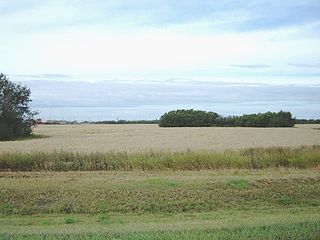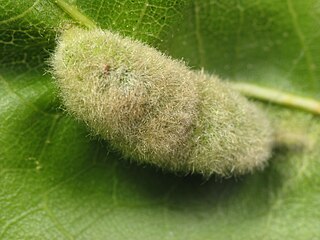
A midge is any small fly, including species in several families of non-mosquito Nematoceran Diptera. Midges are found on practically every land area outside permanently arid deserts and the frigid zones. Some midges, such as many Phlebotominae and Simuliidae, are vectors of various diseases. Many others play useful roles as prey for insectivores, such as various frogs and swallows. Others are important as detritivores, and form part of various nutrient cycles. The habits of midges vary greatly from species to species, though within any particular family, midges commonly have similar ecological roles.

Cecidomyiidae is a family of flies known as gall midges or gall gnats. As the name implies, the larvae of most gall midges feed within plant tissue, creating abnormal plant growths called galls. Cecidomyiidae are very fragile small insects usually only 2–3 mm (0.079–0.118 in) in length; many are less than 1 mm (0.039 in) long. They are characterised by hairy wings, unusual in the order Diptera, and have long antennae. Some Cecidomyiids are also known for the strange phenomenon of paedogenesis in which the larval stage reproduces without maturing first. In some species, the daughter larvae consume the mother, while in others, reproduction occurs later on in the egg or pupa.

Agriculture in Saskatchewan is the production of various food, feed, or fiber commodities to fulfill domestic and international human and animal sustenance needs. The newest agricultural economy to be developed in renewable biofuel production or agricultural biomass which is marketed as ethanol or biodiesel. Plant cultivation and livestock production have abandoned subsistence agricultural practices in favor of intensive technological farming resulting in cash crops which contribute to the economy of Saskatchewan. The particular commodity produced is dependent upon its particular biogeography or ecozone of Geography of Saskatchewan. Agricultural techniques and activities have evolved over the years. The first nation nomadic hunter-gatherer lifestyle and the early immigrant ox and plow farmer proving up on his quarter section of land in no way resemble the present farmer operating huge amounts of land or livestock with their attendant technological mechanization. Challenges to the future of Saskatchewan agriculture include developing sustainable water management strategies for a cyclical drought prone climate in south western Saskatchewan, updating dryland farming techniques, stabilizing organic definitions or protocols and the decision to grow, or not to grow genetically modified foods. Domestically and internationally, some commodities have faced increased scrutiny from disease and the ensuing marketing issues.

The Cecidomyiinae, commonly known as gall midges or gall gnats, is the largest subfamily in Cecidomyiidae with over 600 genera and more than 5000 described species. This subfamily is best known for its members that induce galls on plants, but there are also many species that are fungivores, parasitoids, or predators as maggots.

The economy of Manitoba is a market economy based largely on natural resources. Agriculture, mostly concentrated in the fertile southern and western parts of the province, is vital to the province's economy. Other major industries are transportation, manufacturing, mining, forestry, energy, and tourism.

Hartigiola annulipes is a species of midge fly in the family Cecidomyiidae, found in the Palearctic. The fly was first described by Theodor Hartig in 1839. The larvae gall the leaves of beech.
Alycaulini is a tribe of gall midges, insects in the family Cecidomyiidae. There are about 20 genera and at least 200 described species in Alycaulini.
Paradiplosis is a genus of gall midges, insects in the family Cecidomyiidae. There are at least four described species in Paradiplosis.
Thecodiplosis is a genus of gall midges, insects in the family Cecidomyiidae. There are about six described species in Thecodiplosis.

Macrodiplosis is a genus of gall midges, insects in the family Cecidomyiidae. There are about 19 described species in Macrodiplosis.
Catotricha is a genus of midges in the family Cecidomyiidae. The five described species in Catotricha are found in the holarctic region. This genus was established by British entomologist Frederick Wallace Edwards in 1938.
Craneiobia is a genus of gall midges in the family Cecidomyiidae. There are at least two described species in Craneiobia. They create tube-like galls on leaves of Cornus plants.
Cystiphora is a genus of gall midges in the family Cecidomyiidae. There are about seven described species in Cystiphora.
Micromyini is a tribe of wood midges, insects in the family Cecidomyiidae. There are about 9 genera and at least 30 described species in Micromyini.

Blaesodiplosis is a genus of gall midges in the family Cecidomyiidae. There are at least four described species in Blaesodiplosis.

Lasioptera is a genus of gall midges in the family Cecidomyiidae. There are at least 140 described species in Lasioptera.
Sackenomyia is a genus of gall midges, insects in the family Cecidomyiidae. There are about five described species in Sackenomyia.
Prodiplosis is a genus of gall midges, insects in the family Cecidomyiidae. There are about 11 described species in Prodiplosis.
Acericecis is a genus of gall midges in the family Cecidomyiidae. There are at least three described species in Acericecis.
Miastor is a genus of gall midges and wood midges in the family Cecidomyiidae. There are about seven described species in Miastor.









